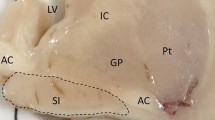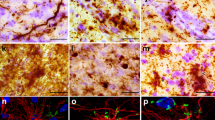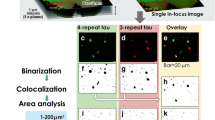Abstract.
The nuclei of the pontine parabrachial region (medial parabrachial nucleus, MPB; lateral parabrachial nucleus, LPB; subpeduncular nucleus, SPP) together with the intermediate zone of the medullary reticular formation (IRZ) are pivotal relay stations within central autonomic regulatory feedback systems. This study was undertaken to investigate the evolution of the Alzheimer's disease-related cytoskeletal pathology in these four sites of the lower brain stem. We examined the MPB, LPB, SPP and IRZ in 27 autopsy cases and classified the cortical Alzheimer-related cytoskeletal anomalies according to an established staging system (neurofibrillary tangle/neuropil threads [NFT/NT] stages I–VI). The lesions were visualized either with the antibody AT8, which is immunospecific for the abnormally phosphorylated form of the cytoskeletal protein tau, or with a modified Gallyas silver iodide stain. The MPB, SPB, and IRZ display cytoskeletal pathology in stage I and the LPB in stage II, whereby bothstages correspond to the preclinical phase of Alzheimer's disease (AD). In stages III–IV (incipient AD), the MPB and SPP are severely affected. In all of the stage III–IV cases, the lesions in the LPB and IRZ are well developed. In stages V and VI (clinical phase of AD), the MPB and SPP are filled with the abnormal intraneuronal material. At stages V–VI, the LPB is moderately involved and the IRZ shows severe damage. The pathogenesis of the AD-related cytoskeletal lesions in the nuclei of the pontine parabrachial region and in the IRZ conforms with the cortical NFT/NT staging sequence I–VI. In the event that the cytoskeletal pathology observed in this study impairs the function of the nerve cells involved, it is conceivable that autonomic mechanisms progressively deteriorate with advancing cortical NFT/NT stages. This relationship remains to be established, but it could provide insights into the illusive correlation between the AD-related cytoskeletal pathology and the function of affected neurons.
Similar content being viewed by others
Author information
Authors and Affiliations
Additional information
Revised, accepted: 25 September 2000
Electronic Publication
Rights and permissions
About this article
Cite this article
Rüb, .U., Del Tredici, .K., Schultz, .C. et al. The autonomic higher order processing nuclei of the lower brain stem are among the early targets of the Alzheimer's disease-related cytoskeletal pathology. Acta Neuropathol 101, 555–564 (2001). https://doi.org/10.1007/s004010000320
Received:
Issue Date:
DOI: https://doi.org/10.1007/s004010000320




